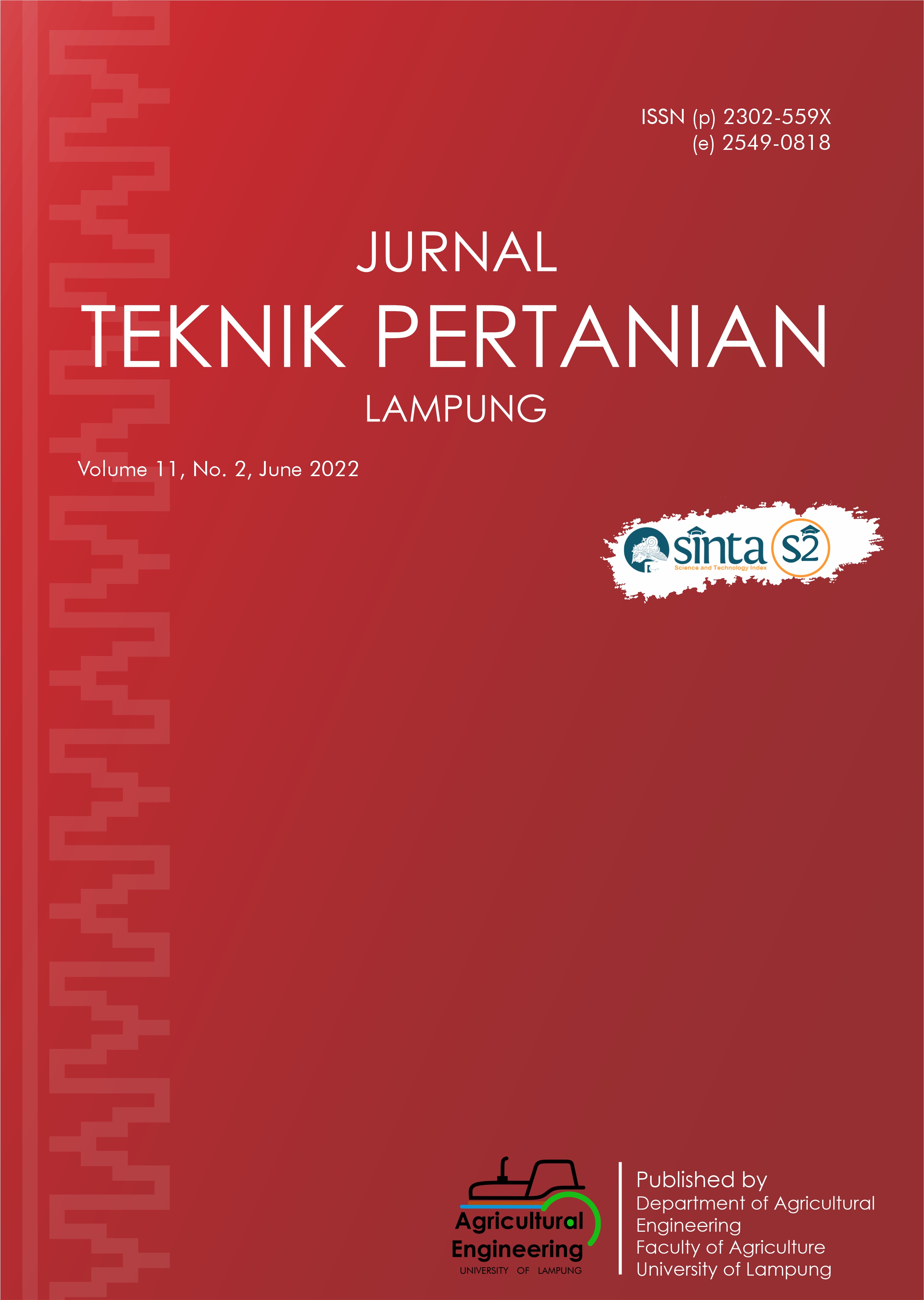Energy Analysis on the Processing of Green Tea
DOI:
https://doi.org/10.23960/jtep-l.v11i2.206-217Abstract
Energy analysis on processing of green tea at green tea factory. Research Institute for Tea and Cinchona (RITC) Gambung was conducted to analyze energy use and identify energy use. Energy analysis is calculated based on the use of biological energy, direct energy, and indirect energy at each process of green tea processing started from withering to packaging activities. This research was conducted with descriptive analysis method by measure and calculate the energy usage for each process. The results showed that the total of energy use in green tea 51.141 MJ/kg. Indirect energy is the biggest energy contributor to the use of total energy (with indirect energy) with energy values reached 46.764 MJ/kg. Meanwhile, the total use of biological energy is 0.01 MJ/kg and the total use direct energy is 4.366 MJ/kg. The results of the energy analysis assestment show that energy savings can be made by maintaining and replacing the damaged parts of the machine especially maintenance of burner in withering process, changing the concept of tea packing to 55 kg of tea/pack, changing the capacity of ball tea machine in the second drying process to 400 kg of dry tea to save the electricity supply system. The results of SWOT analysis showed in quadrant I, where the strategy in this quadrant is S-O strategy, which is growth-oriented strategy.
Keywords: Energy analysis, Energy saving, Green tea, Processing of tea, SWOT
References
Abdullah, K., Irwanto, A.K., Siregar, N., Agustina, S.E., Tambunan, A.H., Hartulistiyoso, E., & Purwanto, Y.A. (1990). Energi dan Listrik Pertanian. Japan International Cooperation Agency. Institut Pertanian Bogor. Bogor
Ang, B.W., & Choong, W.L., Ng, T.S. (). Energy security: Definitions, dimensions, and indexes. Reneweble Energy and Sustainable Energy Review, 42, 1077-1093. https://doi.org/10.1016/j.rser.2014.10.064
Anova, A. (2017). Upaya PT. Perkebunan Nusantara VIII dalam mengembangkan ekspor teh hitam ke Malaysia. Jurnal Online Mahasiswa Fakultas Ilmu Sosial dan Ilmu Politik. Universitas Riau, 4(2), 1-13.
BPS (Badan Pusat Statistik). (2017). Statistik Teh Indonesia 2017. Badan Pusat Statistik Republik Indonesia. Jakarta.
Biantoro, A.W. (2017). Analisis perbandingan efisiensi energi pada gedung P Kabupaten Tangerang dan gedung tower UMB Jakarta. Jurnal Teknik Mesin Mercu Buana, 06(3), 164-173. https://dx.doi.org/10.22441/jtm.v6i3.1966
Cervinka, V. (1980). Fuel and energy efficiency. In Handbook of Energy Utilization in Agriculture USA.
Dewan Energi Nasional. (2014). Outlook Energi Indonesia 2014. ISBN 978-602-1328-02-6. Jakarta.
Hasan, M.I. (2002). Pokok-pokok Materi Metodologi Penelitian dan Aplikasinya. Ghalia Indonesia. Jakarta.
Herwanto, T., Nurjanah, S., Saukat, M., Hafidz, S. 2018. Analisis energi pada proses pengolahan teh hitam ortodoks (Studi kasus PT. Perkebunan Nusantara VIII Kebun Gedeh, Desa Sukamulya, Kecamatan Cugenang, Kabupaten Cianjur, Jawa Barat). Jurnal Teknotan, 12(1), 65-72. https://doi.org/10.24198/jt.vol12n1.7
Hu, Q., Xu, J., & Pang, G. (2003). Effect of selenium on the yield and quality of green tea leaves harvested in early spring. J. Agric. Food Chem., 51(11), 3379–3381. https://doi.org/10.1021/jf0341417
International Tea Committee. (2017). Annual Bulletin of Statistics 2017. International Tea Committee. London.
Kaleemullah, S., & Kailappan, R. (2005). Drying kinetics of red chillies in a rotary dryer. Biosystem Engineering Journal, 92(1), 15-23. https://doi.org/10.1016/j.biosystemseng.2005.05.015
Mancini, E., Beglinger, C., Drewe, J., Zanchi, D., Lang, U.E., Borgwardt, S. 2017. Green tea effects on cognition, mood and human brain function: A systematic review. Phytomedicine Journal, 34, 26-37. https://doi.org/10.1016/j.phymed.2017.07.008
Notoatmodjo, S. (2005). Metodologi Penentuan Sampel Penelitian Kesehatan. PT. Rineka Cipta. Jakarta
Kusuma, W. (2008). Analisis Pucuk Tanaman Teh (Camellia sinensis (L.) O. Kuntze) Di Perkebunan Rumpun Sari Kemuning, PT Sumber Abadi Tirtasentosa, Karanganyar, Jawa Tengah. Skripsi. Fakultas Pertanian, Institut Pertanian Bogor, Bogor
Nurudin. (2016). Kebutuhan Energi: Indonesia Tertinggi di Asean. Bisnis Indonesia. Jakarta
Rohdiana, D. (2015). Teh: Proses, karakteristik, dan komponen fungsionalnya. Foodreview Indonesia, X(8), 34-38.
Sabbaghi, A., & Vaidyanathan, G. (2004). SWOT analysis and theory of constraint in information technology projects. Information System Education Journal, 2(23), 3-18.
Santoso, J. (2008). Petunjuk Teknis Pengolahan The. 2nd ed. PPTK Gambung, Bandung.
Sanusi D., Syahidah, S., & Mahdi, M. 2011. Karakteristik Pellet Kayu Sengon. Fakultas Kehutanan. Universitas Hasanuddin. Makassar.
Setiawan, T. (2010). Audit Energi Pada Sistem Pengolahan Pucuk Teh Menjadi Teh Hitam Orthodox Di PT. Perkebunan Nusantara VIII Kebun Cisaruni, Garut Jawa Barat. [Undergraduate Thesis]. Fakultas Teknologi Pertanian. Institut Pertanian Bogor. Bogor.
Sugiyono. 2011). Metode Penelitian Kuantitatif, Kualitatif dan R&D. Afabeta. Bandung
Taulo, J.L., & Sebitosi, A.B. (2016). Material and energy flow analysis of the Malawian tea industry. Reneweble Energy and Sustainable Energy Review, 56, 1337-1350. https://doi.org/10.1016/j.rser.2015.11.072
Telmo, C., & Lousada, J. (2011). Heating values of wood pellets from different species. Biomass and Bioenergy Journal, 3(7), 2634–2639. https://doi.org/10.1016/j.biombioe.2011.02.043
Downloads
Published
Issue
Section
License
- Authors who publish with this journal agree to the following terms:
- Authors retain copyright and grant the journal right of first publication with the work simultaneously licensed under a Creative Commons Attribution-ShareAlike 4.0 International Lice that allows others to share the work with an acknowledgement of the work's authorship and initial publication in this journal.
- Authors are able to enter into separate, additional contractual arrangements for the non-exclusive distribution of the journal's published version of the work (e.g., post it to an institutional repository or publish it in a book), with an acknowledgement of its initial publication in this journal.
- Authors are permitted and encouraged to post their work online (e.g., in institutional repositories or on their website) prior to and during the submission process, as it can lead to productive exchanges, as well as earlier and greater citation of published work (See The Effect of Open Access).
Jurnal Teknik Pertanian Lampung

JTEPL is licensed under a Creative Commons Attribution-ShareAlike 4.0 International License.

